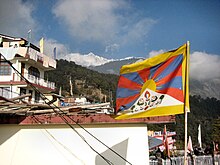The national anthem of Tibet (Classical Tibetan: བོད་རྒྱལ་ཁབ་ཆེན་པོའི་རྒྱལ་གླུ།, Wylie: bod rgyal khab kyi rgyal glu), commonly referred to as "Gyallu", is a Tibetan patriotic song which serves as the de facto anthem of the Central Tibetan Administration.[1]
| བོད་རྒྱལ་ཁབ་ཆེན་པོའི་རྒྱལ་གླུ། | |
 | |
National anthem of | |
| Lyrics | Trijang Rinpoche, 1950 |
|---|---|
| Adopted | 1950 |
| Audio sample | |
Original music of Tibetan National Anthem
| |
It is unclear exactly whether it was first used before the Annexation of Tibet by the People's Republic of China in 1951, or after the 14th Dalai Lama went into exile in India in 1960. The earliest report of a state anthem (presumably "Gyallu") is between 1949 and 1950 when Tibet was under invasion. It was introduced under reforms set in place to strengthen patriotism among the Tibetan people. Another report states that the anthem was presented to the 14th Dalai Lama in 1960 in exile.[2]
Like "Qurtulush Yolida", performance of this anthem is strictly prohibited by the People's Republic of China, particularly in the Tibet Autonomous Region.[1]
Tibet's first national anthem was, according to Tashi Tsering, written by a Tibetan scholar during the epoch of the 7th Dalai Lama and under the reign of the Pholanas in between 1745 and 1746.[citation needed]
Written by Trijang Rinpoche around 1950, a tutor of the 14th Dalai Lama, the lyrics focus on the radiance of the Gautama Buddha.[2]
The melody is said to be based on a very old piece of Tibetan sacred music, and some of its elements are also found in other Tibetan songs such as that of Mimang Langlu, a song of the 1959 Tibetan uprising. The lyrics are by the Dalai Lama's tutor, Trijang Rinpoche. It has been used by Tibetans in exile ever since the introduction of the state anthem although it is banned in Tibet. In 2000's, the anthem was replaced to cleaner version and added the opening melody and closing melody Current anthem of Tibet (Gyallu) but the filename is the sameⓘ
| Standard Tibetan lyrics[2] | English translation[2] | |
|---|---|---|
སྲིད་ཞིའི་ཕན་བདེའི་འདོད་རྒུ་འབྱུང་བའི་གཏེར། |
The source of temporal and spiritual wealth of joy and boundless benefits | |
| Wylie transliteration | Tibetan pinyin[a] | IPA transcription[b] |
srid zhi'i phan bde'i 'dod rgu 'byung ba'i gter, |
Sixi pende dögu jungwai der, |
[siʔ˥.ʑiː˩ pʰɛ̃˥.deː˩ ⁿdøʔ˩.ɡu˩ ᶮd͡ʑuŋ˩.wɛː˩ teɾ˥ ǀ] |
The first Tibetan national anthem was created in the 18th century. According to eminent Tibetan scholar Tashi Tsering, it was composed by Pholanas around 1745, at the time of the 7th Dalai Lama. Sir Charles Bell described it as Tibet's "national hymn".[3]
| Tibetan original | Wylie transliteration | Tibetan pinyin[c] | English translation |
|---|---|---|---|
གངས་རིས་སྐོར་བའི་ཞིང་ཁམས་འདི། |
Gangs ris skor ba'i zhing khams 'di |
Kang ri kor wai shingkam di |
Circled by ramparts of snow-mountains, |